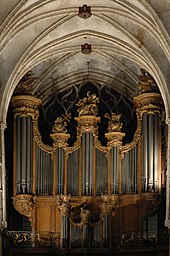St-Séverin (Paris)

The parish church of Saint-Séverin in Paris is located on Rue Saint-Séverin in the Latin Quarter in the 5th arrondissement . It is considered to be the oldest church in the city on the left bank of the Seine .
history
The origin of the church goes back to a hermitage of Severinus of Paris , who is said to have lived here in the 6th century. Various churches have stood where the Gothic church stands today since the 6th century. This was first a Carolingian church which was destroyed by the Normans. Then a Romanesque church, which was demolished around 1220 so that the construction of a Romanesque church could begin in 1230. This burned out in the 15th century, so that the church had to be largely rebuilt. The bell tower, the three western bays and parts of the facade have been preserved from the construction of the 13th century.
The building is a five-aisled basilica without a transept. The dimensions are rather ungothic, with a length of 50 meters and a width of 34 meters, the room height is unusually low at only 17 meters. The triforium, which normally has no openings, is also provided with windows throughout. The windows of the choir were designed in 1966 by the artist Jean Bazaine , and the old windows from the 15th century are also worth seeing. Jacques Pinaigrier is cited as the restorer of the windows in the 1580s . The ambulatory, which is double due to the five-aisle structure, is considered to be the most architecturally valuable part of the church, while the modern stained glass is certainly one of the sights of the church.
On the south side there is a small garden and ossuary .
Gargoyles on the south side
Organs
Organs have been found in Saint-Séverin since the 14th century . Today the church has two organs. A large Kern organ from 1963 and a small Hartmann organ from 1966. The main organ has 59 stops on four manuals and a pedal . The playing and stop actions are mechanical.
|
|
|
|
|
|||||||||||||||||||||||||||||||||||||||||||||||||||||||||||||||||||||||||||||||||||||||||||||||||||||||||||||||||||||||||||||||
- Pair : I / II, III / II, IV / II, II / P, III / P
Individual evidence
- ↑ Information about the organ ( Memento from August 22, 2007 in the Internet Archive )
Web links
- Site plan and photo series Saint Séverin
- official website
- Église Saint-Séverin in the Base Mérimée of the French Ministry of Culture (French)
Coordinates: 48 ° 51 '7.4 " N , 2 ° 20' 44.4" E






